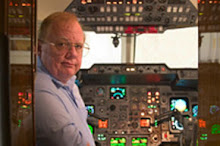Jane Wardell & Andrew Khouri

A Dassault Aviation SA Falcon 7X private jet sits on the tarmac on the fourth day of the Farnborough International Airshow in Farnborough, U.K. on Thursday. The Farnborough International Airshow is being held from July 19-25. (Simon Dawson/Bloomberg)
Airshow Sees Aviation Industry Pulling Out of Long Dive
Farnborough, England. There was an even louder sound than the roar of jet engines during the daily flying display at the Farnborough International Airshow this week — a collective sigh of relief from the civil aviation industry.
New plane orders of almost $29 billion suggest the skies ahead are clearing after a deep two-year downturn, although the defense sector is still scarred by savage government budget cuts.
The airshow “confirms the recovery trend we have been observing for a couple of months as air traffic globally has endured,” Tom Enders, chief executive of European plane maker Airbus, said on Thursday, adding that his company planned to set a new sales target for this year.
New orders at the aviation industry’s premier event didn’t come close to the record-breaking $88.7 billion worth of deals announced at Farnborough in 2008 before the global recession hit.
But they easily surpassed orders of just $7 billion at Farnborough’s sister show at Le Bourget, near Paris — the pair alternate years — last year.
“I’m encouraged by the fact that the economies around the world are moving in a positive direction now,” Gary Scott, president of Bombardier Commercial Aircraft, said on Thursday, the last major business day of the show.
“I think we all know that Europe is struggling maybe a bit more than the US and both are struggling relative to the rest of the world but it’s all moving in the right direction,” Scott said.
The International Air Transport Association recently forecast that the global industry would make a small profit of $2.5 billion this year, after a huge loss of $9.4 billion in 2009 — a marked improvement from its predictions late last year of more losses this year.
Reports from US airlines for the second quarter this week have shown their strongest quarterly results in three years. After huge losses during the recession, Delta, United and US Airways combined to post profits of $1 billion.
But the rebound came with brutal cost-cutting that included the elimination of hundreds of flights each day by the major carriers. That reduced the supply of seats and drove up fares.
Analysts suggest that the aviation industry rebound will be to a “new normal,” where demand will remain weak, prompting likely mergers and acquisitions and a greater focus on streamlining supply and engineering costs.
At Farnborough, the potential changing face of the aviation industry was reflected in the fact that two plane leasing companies — both created just months ago — were among the biggest buyers.
Air Lease bought 54 Boeing 737-8s worth $4.1 billion according to list prices, 51 A-320 family jets worth $4.4 billion and 10 ATR 72-600 turboprops at $221 million. GE Capital Aviation Services bought 60 A-320s worth $4.9 billion and 40 Boeing 737-8s worth $3 billion. Aircraft makers often give discounts to list prices.
Max Sukkhasantikul, Frost & Sullivan’s commercial aviation consulting analyst, said that the deals indicated that many airlines still don’t have the cash flow or credit available to finance their purchases.
“It certainly shows that airlines are moving increasingly toward the leasing model as they try to defer their assets and focus on their core business, which is transferring passengers from A to B,” Sukkhasantikul said.
Among airline buyers at the show were Qatar, Emirates, Qantas, Aeroflot, PT Garuda Indonesia and Flybe.
EADS-based Airbus narrowly beat Chicago-based Boeing in the traditional race for orders between the two companies at major air shows.
Airbus’s deals totaled $13.2 billion, while Boeing’s commitments came in at $12.8 billion.
Both companies are facing challenges to redesign existing aircraft to meet competition from smaller manufacturers from Russia, China, Canada and Brazil.
Brazil’s Embraer and Russia’s Sukhoi won the race for small regional jet orders, leaving Canada’s Bombardier trailing and without any new orders for its much-touted C-series single-aisle jetliner.
The short-haul planes offered by the smaller manufacturers are being snapped up to meet soaring demand for air travel across emerging markets — feeding a rise in low-cost airline start-ups across Asia and Latin America — before an anticipated later upturn in the United States and Europe.
The renewed cautious optimism in commercial aviation, however, could not dispel the bad news from the defense industry, where governments are cutting budgets after spending billions bailing the global economy. Cuts to Western military budgets have been the talk of Farnborough.
In the United States, the world’s biggest defense market, the Pentagon is looking to trim some $100 billion from personnel and procurement costs over the next five years. Britain, Europe’s biggest defense market, is considering cuts of up to 20 percent.
Associated Press
Related articles
Explosions Cause Panic On Board Indonesian Air Plane Flight
1:21 AM 17/07/2010
Merukh in $10b Swap of Ore for Chinese Airplanes
8:55 PM 18/05/2010
Breaking News: 104 Feared Dead in Libyan Plane Crash
2:56 PM 12/05/2010
Breaking News: 105 Feared Dead in Libyan Plane Crash
2:56 PM 12/05/2010
It's about time we see some progress towards recovery of the aviation business with a flood of new airline aircraft being purchased.
